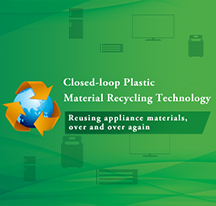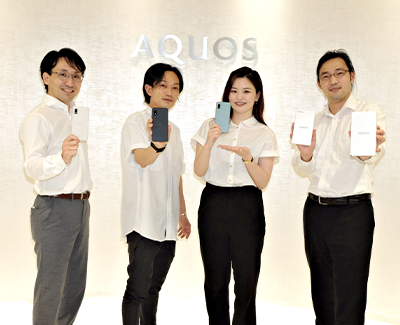
AQUOS "wish" / AQUOS "wish2" 5G smartphone
- Mobile Communication BU
-
- Supervisor from Marketing Promotion Division, Overseas Business Unit: Momoka Fukunaga (2nd from right)
- Product Planning Division, Personal Communication System Business Unit: Koichi Kameyama (far right)
- Development Division, Personal Communication System Business Unit: Masaru Matsumoto (2nd from left)
- Design Studio: Takuya Wake (far left)
Note: Information is current as of June 17, 2022.
The SDGs* (Sustainable Development Goals) are a set of 17 goals for the world to achieve by 2030. Sharp is helping to achieve the SDGs through its business activities.

Sharp has also formulated a long-term environmental vision dubbed SHARP Eco Vision 2050. In it, we have set long-term goals for 2050 in the three areas of climate change, resource recycling, and safety and security—all toward realizing a sustainable global environment. In the area of resource recycling, we are doing our part in creating a circular economy by taking on the challenge of using recycled materials in all product parts and eliminating waste from our corporate activities.

The AQUOS wish series is a “social good” smartphone; for example, it uses 35% recycled plastic for its casing. For this edition of “Always Thinking Green,” we spoke with the people in product planning, development, and design of the AQUOS wish series.
(Interview by “Always Thinking Green” editor)
*A set of 17 goals and 169 targets serving as a guideline for long-term development that the global community needs to achieve in the period from 2015 to 2030.
A new basic smartphone with universal value
AQUOS wish has proven to be a highly popular simple smartphone. How did its development start?
Fukunaga (product planning): The AQUOS smartphone series comprised the flagship AQUOS R, the standard AQUOS "sense," and the midrange AQUOS "zero." But we felt market needs were changing; smartphones have become almost ubiquitous and we realized that more and more customers did not want fancy, sophisticated functions. We needed to come up with a new product that responds to such needs; a smartphone that isn’t simply loaded with functions and that retains the AQUOS series’ “people oriented” concept.
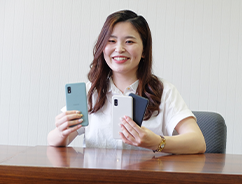
Ms. Fukunaga’s first job in product planning was for AQUOS wish
AQUOS sense’s concept was “necessity and sufficiency.” What’s the concept for AQUOS wish?
Fukunaga: AQUOS wish shares the same concept with AQUOS sense in that it is a smartphone for everyone regardless of age or gender. However, while AQUOS sense is a standard model whose specs evolve and price increases with each new version, the AQUOS wish is focused more on universal ease of use for everyone.
This project was launched in 2020, just as COVID-19 was starting to spread. Our lives changed significantly and our anxieties grew. People began to focus more on being kinder to those around them, cherishing their time, and valuing the important things in their life. We wanted to reflect these feelings in the product concept.
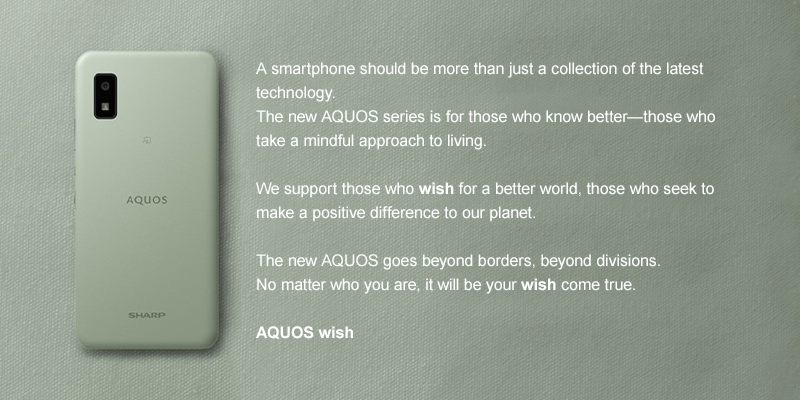
The AQUOS wish concept
So the name “wish” embodies those feelings.
Fukunaga: Yes. We wanted to use a familiar word and give the product a name that reflects people’s feelings and wishes. We also wanted the name to express how the product could benefit the Earth in some small way thanks to its environmental friendliness. The product name also expresses our hope that the developers, designers, and others involved in the AQUOS wish project are happy to have been part of the AQUOS wish team.
A simple and convenient smartphone for everyone—wasn’t that a hurdle for the engineers?
Matsumoto (engineer): To improve a flagship model, you add technologies. This excites me and makes me feel that the product is really evolving. But with AQUOS wish, we had to strip down and minimize functions. I had never engineered a product in this way, so to be honest I was completely baffled at first. We had many intense discussions with Ms. Fukunaga about the product concept (laughs).

Mr. Matsumoto, engineer
Fukunaga: Yes, discussions sometimes became animated (laughs).
Matsumoto: After repeated discussions, Ms. Fukunaga’s passionate ideas on the kind of product she wanted to make gradually permeated the development team. In the end, we all joined forces to overcome numerous hurdles to complete AQUOS wish. Despite the many obstacles, the entire process was enjoyable.
Who took the lead in narrowing down the functions of AQUOS wish?
Fukunaga: Mainly Mr. Kameyama, who is involved in the entire AQUOS series. He had a very difficult time deciding which functions to put into AQUOS wish.
Kameyama (product planning): Because AQUOS wish bears the name “AQUOS,” it needed to incorporate points that are consistent throughout the entire AQUOS line. At the same time, we adjusted the specifications to make them just the right level for the customer, thus keeping in line with the AQUOS wish’s “simple” concept.
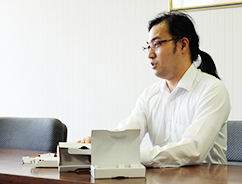
Mr. Kameyama, product planning
Fukunaga: Smartphones are getting bigger and heavier every year. Many have triple-lens cameras and are loaded with functions, making them look impressive and cool. That’s fine, but I wondered if everybody really needs all that in a smartphone. We decided to go against the trend and take a different approach. Instead of creating a sophisticated gadget, we wanted a minimalist smartphone with a single-lens camera and a size that would fit easily in your hand.

